Airhead transmissions
All 4-speed and 5-speed transmissions from 1970 through 1980 are interchangeable, but the entire clutch actuation mechanism is different between the 4-speed and 5-speed. The 5-speed started in 1974. For repair service on these or other BMW transmissions, please visit the Virginia Motorrad Werkstatt page.
Pre-1981 5-speeds
There were two real changes to the early gearboxes:
- shift dogs on 5th gear changed from round to square. The old gear is NLA and then replacement requires a new 4th gear to match it.
- the shift dogs broke off the 2nd gear wheel on the intermediate shaft, causing a loss of drive in 4th gear. This only applied to very early gearboxes; later on the gear was strengthened in that area, requiring a thinner shift fork. Part numbers didn't change! The intermediate shaft for these bikes is NLA so repairing this requires an upgrade to the 17.5° components (see next section) which means changing the fourth gear wheel as described previously. Unless used components are available, this damage effectively totals the gearbox.
There were a few smaller changes as well, such as the change to the shifter seal.
1981-on 5-speeds
Clutch and input shaft
For the 1981 model year, the input shaft was redesigned to accomodate a seal at the rear, which coincided with an overhaul of the clutch and actuation mechanism. This involved many parts: transmission cover, shaft, pushrod, all clutch parts, even the crankshaft.
17.5 degrees
March 1982 the tooth profile of the helical gears (input shaft gear and the 5th gear wheels on the intermediate and output shafts) was changed; these are referred to as the 15° (early) gears and the 17.5° (later) gears. The 17.5° gears are marked with an X, and many people refer to these as X gears.
The first few years of the 17.5° transmissions are particularly susceptible a problem where the shock coupler ears break off the input shaft gear. In March 1985 BMW upgraded the input shaft and gear, eliminating this problem. Here (on the right) is an early 17.5° shaft with broken coupler teeth on the gear. The original part is available as a replacement and is much less likely to fail, or the entire shaft can be upgraded.

Shift kit
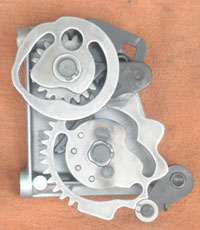
In mid-1981 (effective for most 1982 models) BMW improved the shift mechanism. The parts involved were available for a long time as kit 23 31 9 056 150 but are now only available as separate parts. The effect of this kit was to provide larger detents for each gear, to reduce the likelihood of false neutrals, and to keep the pawl from disengaging if the spring broke.
A) 23 31 1 451 563 shifting cam 3-4
B) 23 31 1 231 578 segment shaft
C) 23 31 1 242 892 pawl
D) 23 31 1 231 611 shifting cam 1-2-5
E) 23 31 1 242 910 spring
With the upper shift cam removed and flipped over it's easier to see the changes. The old style is on the left and the new is on the right. Cam A now has a round hub to work better with the revised pawl C. Shaft B has an offset to provide a bit more clearance between the pawl C and cam D (on the original version they basically rub against each other) which can be seen by the line where there is a crease in the part. Pawl C is totally revised and its movement is limited as to how far away from the shift cam D it will go, limited by hitting the hub of cam A. Cam D has taller and pointier peaks. The spring cannot really be seen in the photo; it keeps pawl C pressed against the pins of the shift cam D.
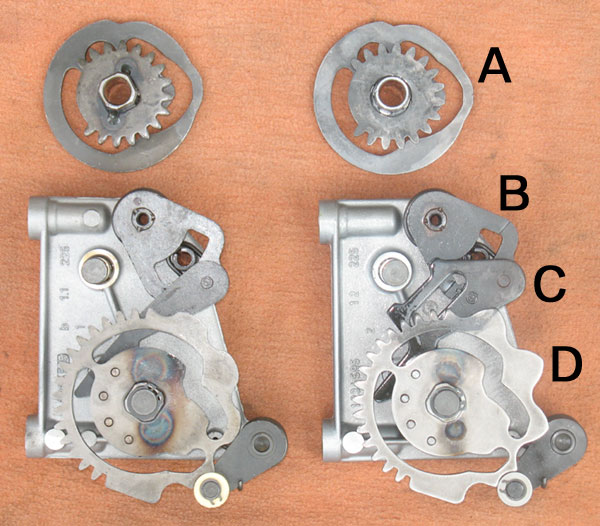
Circlip issue
At some point around 1985, BMW dropped the circlip on the front end of the output shaft. It was reinstated around 1994, but the gearboxes produced in that time frame are at risk for excessive bearing wear. Here is a description of repairing the problem.
Neutral switches
In 1976 the neutral switch was changed. Up through 1975 the switch was pushed in to make the neutral contact, and starting in 1976 the switch extended to make contact. Looking at the two shift cams in the following picture, you can see the difference. These shifters are in neutral; the red line indicates where the neutral switch (red arrow on the bottom left) reads the topmost shift cam. You can see the difference.
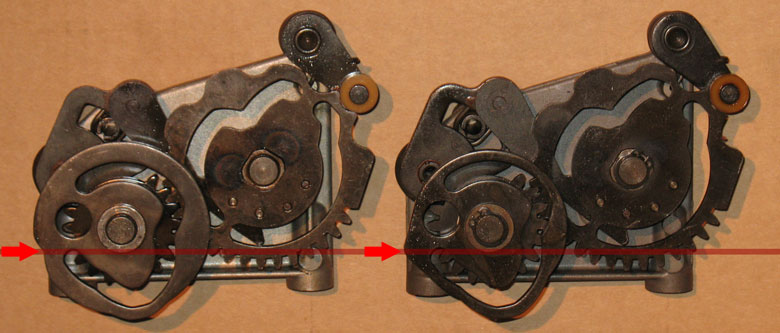
Early design on the right, where the switch gets pushed in for neutral.
4-speed transmissions
These were from my very early 4-speeed transmission.
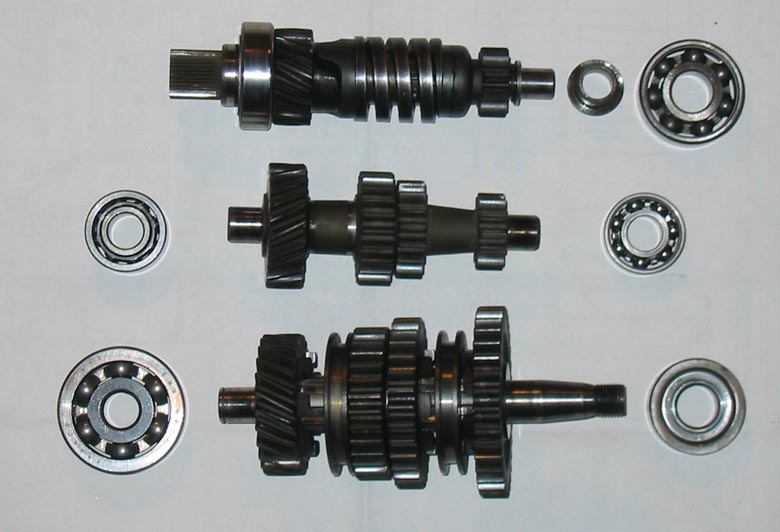
I found an oddity with the shift lever return spring. There was a sleeve under it, which is not pictured in any manuals but is referred to in the BMW repair manual text. With this sleeve in place, the spring will bind and break (possibly explaining why this one was broken when I got it). Pictured is the shifter assembly; the sleeve was under the spring (you can see there isn't enough room for it). During the /5 production, this part of the mechanism (the large bushing under the spring, and the washer separating it from the ratcheting arms) was changed. ETK only shows the new version; the old one is shown in the /2 literature.
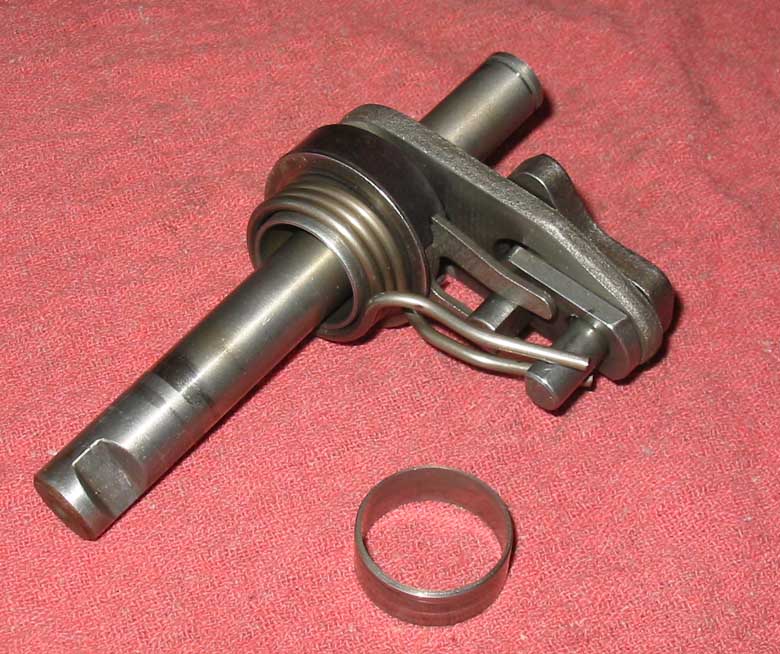
Shims
48mm plate - input shaft rear, both transmissions
39mm - 4-speed cluster shaft
47mm - 4-speed output shaft
52mm - 4-speed input and all 5-speed
| 48mm plate | 39mm | 47mm | 52mm | |
|---|---|---|---|---|
| .20mm | 23 21 1 230 966* | 23 21 1 231 651 | 23 21 1 233 475 | |
| .28mm | 23 21 1 230 967 | 23 21 1 231 652 | 23 21 1 231 625 | |
| .38mm | 23 21 1 230 448 | 23 21 1 230 968 | 23 21 1 231 653 | 23 21 1 231 626 |
| .50mm | 23 21 1 230 449 | 23 21 1 230 969 | 23 21 1 231 654 | 23 21 1 231 627 |
| .63mm | 23 21 1 231 363 | 23 21 1 231 655 | ||
| .75mm | 23 21 1 230 450 | 23 21 1 231 656 | ||
| .88mm | 23 21 1 230 451 | 23 21 1 231 657 | ||
| 1.0mm | 23 21 1 230 452 | 23 21 1 231 658 |
* 0.18mm
red = discontinued, NLA
4-speed transmissions originally used various sizes of the 48mm plate, but most have been discontinued. Shimming is now done using 52mm shims with a single .50mm plate. A 1.0mm plate may be too tight, even without shims.
Cycleworks sells shims that are NLA from BMW. Oilhead shims are available in 47mm and 52mm sizes (.30 to .55, +.05).
Bearings & seals
| Partnumber | Type | Location | |
|---|---|---|---|
| B E A R I N G S |
23 12 1 231 495 | 6304 no seals | Various locations |
| 07 10 1 468 914 | 3203 TNH 40x17x17.5 | 4sp front inter | |
| 07 11 9 981 214 | 6203 40x17x12 | 4sp rear inter | |
| 23 12 1 338 795 | 6403 62x17x17 | Front output | |
| 07 10 1 468 880 | 6204 47x20x14 | 4sp rear output | |
| 23 21 1 235 449 | 520449, NU204E 47x38x26 w/ long inner race |
5sp front input | |
| 23 12 1 233 808 | 6304 seal on outside | 5sp rear cluster | |
| 23 12 1 338 466 | 6304 two seals | Paralever rear output | |
| S E A L S |
23 12 1 230 088 | 4sp front input shaft seal | |
| 23 12 1 230 087 | 4sp output shaft seal | ||
| 23 12 1 338 741 | 28x17x7 | Kickstart seal | |
| 23 11 1 006 124 | 24x7x15.7 | 4sp and early 5sp shifter seal | |
| 23 12 1 338 726 | 40x26.5x9 | 5sp input shaft seal | |
| 23 12 1 232 681 | 66.3x40x7 | 5sp output shaft seal | |
| 23 12 1 338 514 | 66.3x40x7 | Paralever output shaft seal | |
| 23 12 1 338 740 | 26x16x7 | '75-on shifter seal |
All bearings C3 clearance unless noted.
(1) Except a different bearing was used and then discontinued around the time that the circlip was omitted from the output shaft.
(2) Early '74 model 5-speeds used the 4-speed shifter seal.
Links
Duane Auscherman's website and transmission page (mostly 4-speed)
Joerg Hau's transmission rebuild page (5-speed)
Jim Buchanan's page on replacing bearings (4-speed)
Robert Fleischer's website and transmission page (mostly historical info)
Cycleworks' website (transmission tools and bearings)

